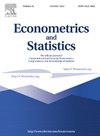通过典型相关分析估计大T和N因子模型中共同趋势的数量
IF 2.5
Q2 ECONOMICS
引用次数: 0
摘要
当对长度为T的N个时间序列的水平和累积水平进行分析时,得到典型相关的渐近结果,该时间序列由具有s个常见随机趋势的因子模型生成。对于T→∞和固定的N和s,最大的s平方正则相关收敛于一个非退化极限分布,而剩余的N−s在概率上收敛于0。此外,如果s在N中最线性增长,则最大的s平方典型相关在概率上收敛于1,为(T,N)seq→∞。这一特性使人们可以估计共同趋势的数量为相邻标准相关的平方下降幅度最大的整数。在极限处最大间隙等于1,证明了该准则是一致的。蒙特卡罗模拟研究说明了这一发现。本文章由计算机程序翻译,如有差异,请以英文原文为准。
Estimating the number of common trends in large T and N factor models via canonical correlations analysis
Asymptotic results for canonical correlations are derived when the analysis is performed between levels and cumulated levels of N time series of length T, generated by a factor model with s common stochastic trends. For T→∞ and fixed N and s, the largest s squared canonical correlations are shown to converge to a non-degenerate limit distribution while the remaining N−s converge in probability to 0. Furthermore, if s grows at most linearly in N, the largest s squared canonical correlations are shown to converge in probability to 1 as (T,N)seq→∞. This feature allows one to estimate the number of common trends as the integer with largest decrease in adjacent squared canonical correlations. The maximal gap equals 1 in the limit and this criterion is shown to be consistent. A Monte Carlo simulation study illustrates the findings.
求助全文
通过发布文献求助,成功后即可免费获取论文全文。
去求助
来源期刊

Econometrics and Statistics
ECONOMICS-
CiteScore
3.10
自引率
10.50%
发文量
84
期刊介绍:
Econometrics and Statistics is the official journal of the networks Computational and Financial Econometrics and Computational and Methodological Statistics. It publishes research papers in all aspects of econometrics and statistics and comprises of the two sections Part A: Econometrics and Part B: Statistics.
 求助内容:
求助内容: 应助结果提醒方式:
应助结果提醒方式:


